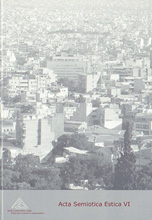“Alguse” ja “lõpu” kui linna kirjeldamise vahendite kuulumisest linna juurde
“The beginning” and “the end” as a descriptive tools and aspects of city
Author(s): Tiit RemmSubject(s): Semiotics / Semiology
Published by: Eesti Semiootika Selts
Keywords: city; the beginning and the end; time and space; Sillamäe; Tartu; linn; algus ja lõpp; aeg ja ruum; Sillamäe; Tartu
Summary/Abstract: The beginning or the end are concepts often associated with a city in common understanding, arts as well as in research. Although the beginning is something that has already occurred but the end has not, there still exists certain logical symmetry between them. For Lotman (and Uspensky) the beginning and the end of a city (St. Petersburg) are strongly connected with the textualizing function of a frame. Description through categories of the beginning and the end gives a narrative dimension to a city and links it with its (self)validating activities — aspect clearly visible for example in various descriptions of Sillamäe. Concepts the beginning and the end connect the realms of time, space and moral. The presence of those three aspects does not allow reducing the beginning and the end of a city to a simple linear historical-predictive narrative but needs semiotical mechanisms to deal with them — to mark or eliminate their presence. Aside from artistic texts or common understanding, the concepts of the beginning and the end are also important in theoretical research. It appears that the beginning and the end are doubly modelling devices: the modelling devices of a modelling of a city as culture and thus doubly ideological and without independent existence. The beginning and the end as a descriptive device does not only indicate to the nature of a city but also to the nature of culture described through city.
Journal: Acta Semiotica Estica
- Issue Year: 2009
- Issue No: 6
- Page Range: 086-105
- Page Count: 20
- Language: Estonian

